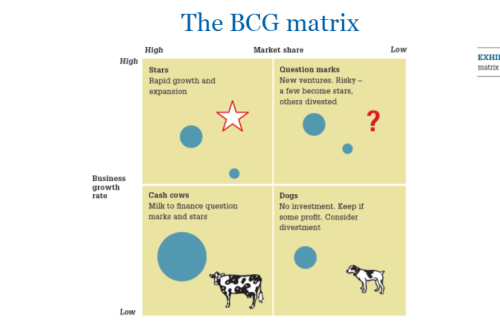-
what is management?The organisation and coordination of the activities of a business in order to achieve defined objectives.
-
what is the process of managementresources-> (planning, organising, leading, controlling)-> performance
-
what is planning?defining goals for future organisational performance, deciding on tasks, and resources needed
-
what is organising?resource allocation, task assingment and departmentalisation
-
what is leading?influencing employees to achieve organisational objectives
-
controllingMonitoring employees activities, tracking organisation towards its goals
-
what characterises organisational performanceeffectiveness (extent organisation achieves objectives) and efficiency (resources used in order to fulfil objectives)
-
what are the 3 management skills?conceptual, human, technical
-
what is conceptual skills?ability to see organisational as whole, with interdependent relationships
-
what are human skills?ability to work with and through others. be an effective team member
-
what are technical skills?industry specific skills, analytical skills. performance of specific task
-
what are manager roles?informational, interpersonal, decisional
-
what is decisional management roles?entrepeneur, disturbance handler, resource allocator, negotiator
-
what are interpersonal roles?figurehead, leader, liason
-
what are informational roles?monitor, disseminator, spokesperson
-
what is classical perspective?Emerged during the 19th and early 20th centuries as a response to new problems arising from industrialisation (environmental forces)
-
what is scientific management?Develop standard method for performing each job Select and train workers Support workers (careful planning) Provide incentives (wages)
-
what is bureaucratic organisations?Originated by Max Weber • Focused on:–Rational authorityand formal structure–Employee selection and advancement based on merit rather than ‘who you know’ –Rules and written records –Authority based on position/legal power
-
what is administrative principles?Unity of command • Division of work • Scalar chain • Unity of directiontotal organisation focus
-
what is humanistic perspective?Emphasised the importance of understandinghuman behaviours, needs and attitudesin the workplace
-
what is the human relations movement?Suggests effective control comes from within individuals, not adherence to strict, authoritarian control
-
what is indicated in the hawthorne studies?Highlighted positive link between humane treatment ofworkers and productivity
-
what is human resources perspective?Further developed the idea of considerate leadershipand worker participation• Combines prescriptions forjob design and theories of motivation
-
what is theory x and theory yTHEORY X assumptionshumans dislike workmust coerce, control, direct and punish in order to achieve organisational objectivesperfers to be directed, avoids responsibilityTHEORY Y assumptionsphysical and mental effort is naturalexternal control is not the only effective way of bringing humans to achieve organisational objectiveslearns and accepts responsibilitycreativity, imagination etc, are common in problem solvinghumans are not at full capacity in industrialised society
-
what is behavioral sciences approach?use of sociolog, econimics and psychology in organisational context
-
what is the management science perspective?quantitative techniques to assist with organisational problesm
-
what is systems thinking?open systems, entropy, synergy, interdependence in systems
-
what is contingency view?what works in one situation doesnt work in another. each case is unique
-
what is total quality management?employee involvement, customer focus, benchmarking, continuous improvement
-
external environmentoutside organisational boundaries, General and Task
-
general environmentinternational, technological, socio cultural, legal-political, natural environment, (not day to day or directly impacting)
-
task environmentCustomersCompetitorsSuppliersLabour market
-
how can organisations adapt to the external environmentBoundary spanning roles, forecasting and planning, interorganisational partnerships, mergers and JVS
-
what comprises the internal environment?Corporate/organisational cultureProduction technologyOrganisation structurePhysical facilities
-
what is organisational culture?Refers to the shared knowledge, beliefs, values, behaviours and ways of thinking among members of the organisations
-
what are the 2 levels of culturevisible (tangible) and invisible *assumptions and beleifs)
-
adaptability culturedecentralised decision making, fast response, creativity and innovation
-
achievement cultureresults orientated,Values competitiveness, personal initiative, cost-cutting and achievement
-
involvement cultureValues cooperation, consideration and equality
-
consistency cultureValues and rewards a methodical, rational, orderly way of doing things:Following rulesBeing thrifty
-
cultural leadershipInfluence culture in two key areas:Articulation of a vision for the organisational culture that employees can believe in.Heeds the day-to-day activities that reinforce the cultural vision.
-
stages of globalisation1. domestic2. international3. multinational stage4. global
-
global mindsetGenuine interest and curiosity in other culturesOpen-mindednessAbility to deal with ambiguity and complexity
-
multinational corporations (MNC)>25% sales overseas
-
international tacticsExportingselling overseasoutsourcingforieng nation doing part of businesslicensingfranchising etcdirect investingsubsiadaries
-
managerial ethicsRefers to the code of moral principles and values that governs managerial behaviour and decision making
-
domains of human actiondomain of codified law <-domain of ethics<-domain of social standards
-
utilitarian approachgreatest good for greatest amount
-
individualisimindividuals long term best interests
-
moral rightsfree consentfreedom of speech
-
justice approachequity, fairness and impartialityDistributivedifferent treatment is not based on characteristicsproceduralfair enforcement of rulescompensatorycompensation of injuries incurred by party responsible
-
practical approachstandards of profession, larger society, industry
-
moral developmentpre-conventionalinside law, avoiding punishmentconventionalsocial standardspost conventionalpersonal standards
-
corporate social responsibilitythe obligation of organisation management to make decisions and take actions that will enhance the welfare and interests of society as well as the organisatio
-
green movementeconomic development, inficuing wealth and meets needs of population, and allowing for future sustainability
-
EVALUATION OF CSRECONOMICSprofitLEGALobey lawethicaldo what is rightdiscretionarycontributing to community
-
managing company ethicsethical leadership, code of ethics, ethical structure, support whistleblowers
-
levels of goals and plansStrategic goals• Pertain to the organisation as a whole.–Tactical goals• Relevant to specific part of organisation–Operational goals• Developed at lower levels that specify action steps towards achieving organisational goals that support tactical planning activities
-
planning processdevelop the plan, translate plan, plan operations, execute plan, monitor and learn (this is a cycle)
-
criteria for effective goals1. Are specific and measurable2. Have a defined time period 3. Cover key result areas 4. Are challenging yet achievable 5. Are linked to rewards
-
management by ObjectivesMBO–Set goals (involves all employees at all levels)–Develop action plans –Review progress–Appraise overall performance
-
benefits and implications of MBOFocuses manager and employee efforts on activities that will lead to goal attainment• Can improve performance at all levels• Improves employee motivation • Aligns individual and departmental company goalsProblems occur when MBO is used inappropriately–Over-emphasis on goal attainment can lead to cutting corners• MBO is not a stand-alone plan • Alternative is MBM–Management by means which focuses attention on the methods and processes used to achieve goals
-
contingency planningDefines organisation response to specific situations such as emergencies, setbacks or unexpected conditions
-
scenario planningPossible scenarios based on extrapolating from current trends and considering future discontinuities
-
crisis planningPreventiondetectionrelationship buildingPreperationcrisis management teamdetailed crisis management plancommunications systemContainmentrapid responseget truth outmeet safety and emptional needsreturn to business
-
strategic management–A plan of action describing resource allocation and activities for:• dealing with the environment • Achieving a competitive advantage • Attaining goal
-
elements of competitive advantagetarget customers, core compentence exploitations, achieve synergy, create value
-
levels of strategycorporate levelswhat business are we in?business levelhow do we competefunctionalhow do we support business level strategy
-
corporate level strategy formulation
 portfolioRelates to the organisation’s mix of strategic business units and product lines that fit together in such a way as to provide the organisation with synergy and competitive advantageBCG matrixdiversificationnew lines of business, vertical integration (expansing into supplies, distribution etc)
portfolioRelates to the organisation’s mix of strategic business units and product lines that fit together in such a way as to provide the organisation with synergy and competitive advantageBCG matrixdiversificationnew lines of business, vertical integration (expansing into supplies, distribution etc) -
porters 5 competiive forcesbusiness level strategypotential new entrantssubstitute productsbuyerssuppliersstrategiesdifferentiatecost leadershipfocus
-
functional level strategyaligning plans to business level strategies
-
organisational structurehe set of formal tasks assigned to individuals and departments 2. Formal reporting relationships 3. The design of systems to ensure effective coordination of employees acrossdepartments
-
work specialisationRefers to the degree to which organisational tasks are subdivided into individual jobs, or division of labourincrease efficienctreduces motivationsilo effects
-
authority and key charactersiticsRefers to the formal and legitimate right of a manager to make decisions, issue orders and allocate resources to achieve organisationally desired outcomeKey characteristics:1. Authority is vested in organisational positions, not people2. Authority flows down the vertical hierarchy 3. Authority is accepted by subordinate
-
tall structure vs flat structureTall structure• Narrow span of control • More hierarchical levels • Slower decision makingFlat structure Trend toward this • Broader span of control • Relatively few hierarchical levels
-
centralisationdecision authority at top levels
-
decentraliseddecision authority lower in organisation
-
formalisationformal document used to direct and control employees
-
departmentalisationThe basis on which individuals are grouped intodepartment and departments into total organisations
-
vertical functional approach to departmentalisation and analysisPositions grouped into departments based on similar skills, expertise and resource usebenefitseconomies of scaledevelopment of skillscareers progressionsynergysmaller organisation suitabilityimplicationsslower responseidentify with function rather than whole of organisationpoor communication and coordinationpoliticking between dept
-
divisional approach of departmentalisation and analysissimiliar organisational outputself containedproductspecialise on each productinternationaldivide into autonomous geographical areaslocal responsivenessadvanatagesfast foster customer needsexcellent cross functional dept coordinationaccountabilityoverall product and dividion focusgeneal management skill developmentdisadvantagesduplication of resourcesless specialisationpoor coordination in divisionsless management controlcompetition for resources (within organisation)
-
matrix approachfunctional and divisional chainsdual commandoften global use
-
team basedfosters flexibility and quicker response
-
network approachcentral hub and external specialists
-
factors shaping structurefollow strategyreflects the environmentfits technology
-
human resourcesthe personnel of a business or organization, especially when regarded as a significant asset.
-
human resource managementattract, develop and maintain effective workforce
-
strategic human resource managementfind right people, management of talent and maintain effective workforce
-
HRM planningrecruiting, selecting and managing of talent
-
attract effective workforcehr planning, choose recruiting source, select, welcome
-
recruiting processjob analysisgathering and interpreting about essential duties, tasks and responsibilitiesdescriptionconcise summary of tasks and responsiblitiesspecificationknowledge skills, education and capabilities needed
-
selecting HRMThe process of determining the skills, abilities and other attributes a person needs to perform a particular job
-
development of effective workforceon the jobsocial learningmentoring and coaching
-
performance appraisalevaluation of employee performance, providing feedback360 degress, multiple raters and self assesment
-
leadershipability to influence people to attain organisational objectives
-
level 5 leadershiphierachy of management capabilties, top level being level 5 where no self ego, and doing all to do what is best for organisation
-
servant leadershipserve others, organisation and societyfulfil subordinates needs and goalsdo waht is best for overall organisation
-
authentic leadershipleading with head and heart
-
management vs leadershipmanagement promotes stabilityi and efficiency whereas leadership induces engagement and change to meet new and uncertain conditions
-
behavioural approachesleadership behavior and the extent it contributes to success and failurepeopletask


